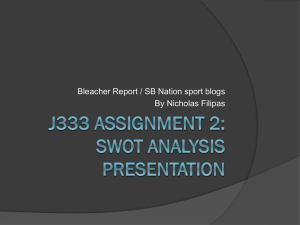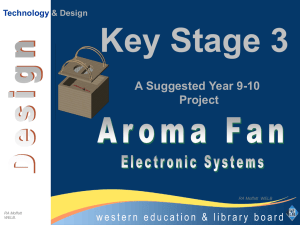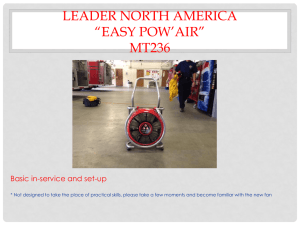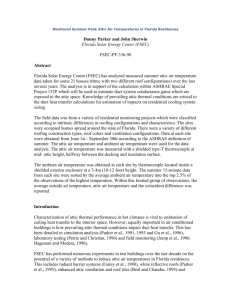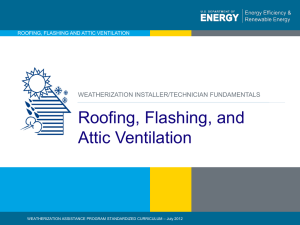Presentation
advertisement
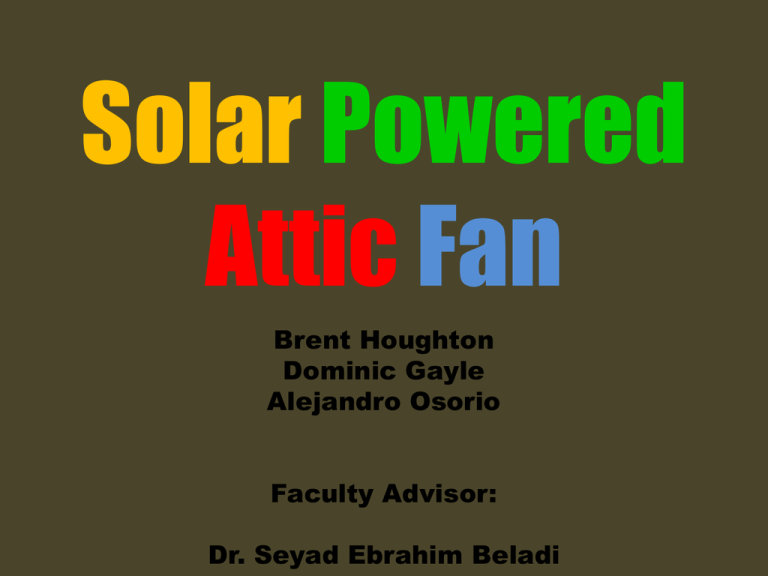
Solar Powered Attic Fan Brent Houghton Dominic Gayle Alejandro Osorio Faculty Advisor: Dr. Seyad Ebrahim Beladi Household Attic Temperatures in attics can reach up to 140 Degrees Fahrenheit Infiltrations/Air leakage into household Results in increased strain on A/C Turbines and Fans Visually Unappealing Provide Little Ventilation Power Consumption Current Market Weaknesses Most current models do not implement a rechargeable battery. Under powered and overestimated in terms of performance. Geographic orientation on roof is confined to solar angles. General Design Major Components 4 X Sunforce 50022 5 Watt Trickle Charger configured in parallel Current: 325 mAmps @ 15 V Diode to prevent reverse discharge from battery Pulse Width Modulator to govern RPM’s • • • An pulse width modulator, or PWM, is an electronic circuit which is primarily used to vary an electric motor's rotational speed and direction it may serve as a dynamic brake as well. ESCs are often used on electrically powered radio controlled models, with the variety most often used for brushless motors essentially providing an electronically-generated three phase electric power low voltage source of energy for the motor. • trol. Sunforce 7 Amp Solar Charge Controller • • • Protects battery from overcharge/discharge. Handles up to 7 Amps of array current. Maintains 12 Volt battery in a fully charged state. Powersonic PS-12350-NB Deep Cycle Battery • • • • 12 Volt/35 Amp Hour Sealed Lead Acid Battery Deep Cycle Battery intended for high charge/discharge rate. Wide operating temperatures ideal for attic conditions. Valve regulated, spill proof construction allows for safe operation in any position. Procomp 14” Pusher/Puller Fan • 12 Volt DC high performance reversible electric cooling fan. • Blades and wire polarity may be reversed for pushing/pulling option. • 2000 CFM rating. GadgetZone CN101 Digital Programmable Timer • Programmable for 17 ON/OFF events per day. • Dual installation allows for air outake/intake. • Lithium battery to prevent short during power outage. Fundamental Design • 4 solar panels charge battery daily. • Allows for continuous usage during night and day. • CFM/s may be adjusted due to power budget. Fundamental Design: Housing Structure Fundamental Design: Automatic Control Panel Potential Problems • To generate enough current to sufficiently charge battery to power motor driven fan? • Heat from attic can be a strain on battery • Higher cost than conventional solar fans, yet more advanced • Sleek design with regard to marketing Literature Survey Attic Fans. Solar powered attic fans. Photovoltaic Cells Attic Fans Used in warmer and cold climates. Summer months temperature can reach 160 F. Moisture and cold can lead to mildew growth in the attic as well on winter season. Moisture on Attics http://www.ussunlight.com/images /product_images/products_general/ winter_apv.jpg http://www.bluepointenvironmental.com/ wp-content/uploads/2012/01/atticcontamination1.jpg Summer Season on Attics http://poweredbydaylight.com/wpcontent/uploads/2011/03/attic-heat-300x300.jpg Solar Attic Fans Solar attic fans are available for general consumer on retail stores. No efficient product limited to a power delivered for a photovoltaic cell. Generally Solar Attic are not very aesthetically pleasing to homeowners. Photovoltaic Cells http://www.ecoplanetenergy.com/wp-content/uploads/2012/03/solar-PV-energy-origins.gif Environmental Impacts Most components pose no threat. Battery is rechargeable. Runs on direct current. Ideal for any suitable geographical locations In which a need arises. Generate large amounts of electricity without producing any pollution to the ambient surroundings or adding to global warming. Photovoltaic cells can have working lives of up to 30 years Manufacturing companies must employ proper protocols to prevent exposure of these chemicals to the environment. http://grist.files.wordpress.com/2013/04/s olar-panels-homepage.jpg http://www.think-solar-power.com/PhotovoltaicSolar-Power.html Low impact to the ambient on manufacturing process. Optimize equipment use and extend operation hours. http://www.dbpow.com/ http://www.sunforceproducts.com/ POWER SONIC 96% of all lead-acid batteries are recycled. Almost any retailer collects used batteries for recycling (State laws) They send the plastic to a reprocessor for manufacture into new plastic products. lead-acid battery contains 60 to 80 percent recycled lead and plastic. http://www.batteryweb.com/power-sonic-corporation.cfm http://ecobatgroup.com/ecobat/rp/ Housing, blades and mounting brackets are made from plastic. Cooper coil winding. Indirectly Powered by Solar Energy. http://blog.heliumware.com/wpcontent/uploads/2011/01/IMG_0111.jpg . http://thumbs2.ebaystatic.com/d/l225/m/mQzgm6 y2pubd8L75antwOYg.jpg ASHRAE – American Society of Heating, Refrigerating, and Air-Conditioning Engineers. ASCE – American Society of Civil Engineers. ASM - American Society for Metals. (6061) ASME - American Society for Mechanical Engineers. IEEE - Institute of Electrical and Electronics Engineers. ANSI – American National Standards Institute. • Tropical storms and hurricanes are devastating and as such steps must be considered in design. Category Wind Speed (m/s) Wind Loading (N) Wind Loading (lbf) Storm 32 165 37 1 42 285 64 2 49 388 87 3 58 544 122 4 70 792 178 • Wind Loading = 0.5ρv2CdA • Cd ranges from 1.2 - 1.65. Use 1.65 for safety. • Analysis conducted as if force acted perpendicularly to housing. • Initial model used to conduct analysis. • Due to software limitations, certain concessions were necessary. • Greatest stresses were concentrated in the bends of the housing. • Safety factor of 1.2 under tropical storm loading. • 49 MPa maximum stresses within the bended regions. • Safety factor of less than 1. • Recommended fastener : #8 X 2” screw, self-tapping and galvanized – ASTM standard. • Length will vary depending on roof thickness. • 650 screws for $34.55. • Housing failure more significant than fasteners. • Poor aerodynamic structure results in tremendous wind loading. • Remove attic fan for conditions greater than tropical storm loading. • Simulation conducted with hemispherical dome. • Diminished area results in max velocity of 4.4 m/s (13 fps). • Highest pressure experienced around outlet regions of housing. Outdoor Temperature (°F) Indoor Temperature (°F) Attic Temperature Before Activation Cycles (°F) Attic Temperature After Activation Cycles (°F) Attic Temperature Difference (°F) 85 78.0 106.3 92.4 13.9 82 79.1 102.5 85.6 16.9 85 78.0 107.9 92.4 15.5 • Based on fan drawing 1.8 Amps @ 600 CFM for 90 second interval (expulsion cycle). • Resting interval for 60 seconds (no fan activity). • Based on fan drawing 1.8 Amps @ 200 CFM for 60 second interval (intake cycle). é W ù ê CFM * DT *1.08 AC tons *1300 AC tons ú hours of operation*ê ú - Fan Power 12000 ê ú ë û Energy Savings = W 1000 kWh • Estimate of 4.31 kWh/day savings. • Investigate a real-world global issue and use engineering knowledge to address it. • Gain valuable experience and insight into manufacturing process. • Importance of team work i.e. goal specifications, task delegation, conflict resolution ,etc. Questions? Comments?



